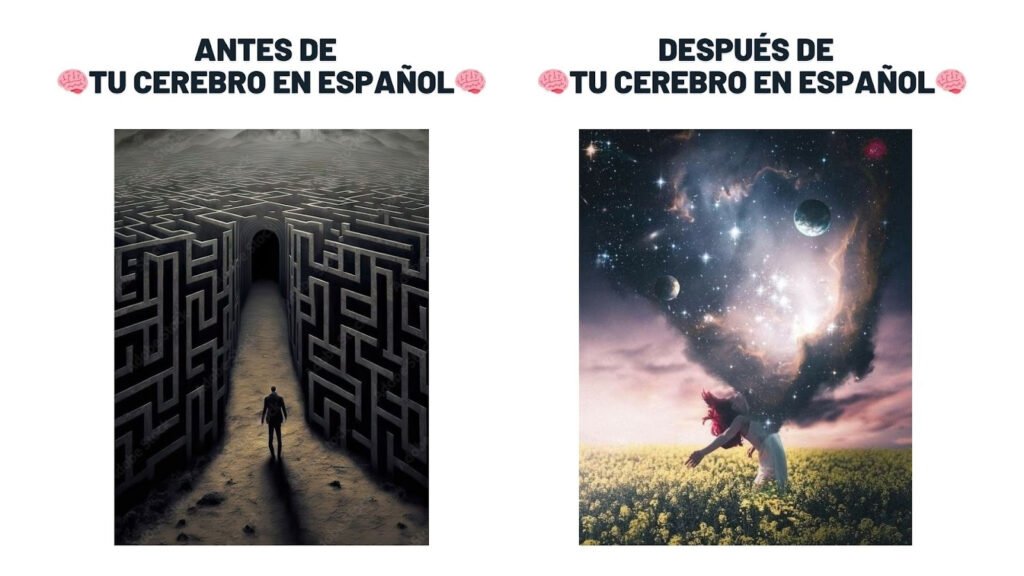Imagine you’re moving to Spain next year…
Imagine being able to order effortlessly at the bakery surrounded by locals. Understanding neighbors’ casual conversations in an alley. Reading between the lines in deep conversations with your Spanish friends at 4 a.m. in the kitchen. Knowing what to say at a Tinder date.
This course isn’t just about speaking Spanish. It’s about becoming part of the culture rather than just observing it.
The first thing you’ll learn in this course is how we, native speakers think. You’ll understand the way we make sense of the world: how we organize our ideas, our emotions, and our conversations through grammar. Until you incorporate these concepts into your brain, you’ll continue to sound like someone who spends summers in Spain and uses subjunctive mood because they have memorized it rather than it coming out naturally. Remember: someone who speaks poorly may be seen as stupid regardless. Some consequences of this are:
- You get to participate only in official event groups, not in the inner circles where people gossip and share memes.
- Feeling lost in company meetings with your colleagues.
- Keep going to expats-only events, speaking in English. Of course, you’ll never be able to connect with the locals this way.
- Get the pun ten seconds late, while everyone else is already laughing out loud.
This course is not for those who just want to order a mojito at a beach bar and go right back to their Airbnb. It’s for people who want to live their lives in Spanish for real, just like I live mine: I’m not someone who’s stuck inside four walls. That’s why I know how Spanish is actually used – on the streets, at work, in life, and emotionally.

I know psychological implications of, for example, using indefinite tense instead of the imperfect, even though both are valid in the same sentence. What we’re going to explore in this course is: what do you want to say? Alright, but what are you actually expressing? What effect does the use of one tense or another have on the other person’s mind? Other teachers will tell you that your sentence is correct, which grammatically it may be, but I go beyond the grammar. I talk about nuances and psychological consequences that are conveyed with each verb tense, about hidden messages that the listener receives.
You can tell right away if someone studied grammar from a book written in the Paleolithic era, or when they’re looking up in their head one of the 13894 rules learned from a YouTube video. It’s monotonous and predictable. With 🧠 Your brain in Spanish 🧠, native speakers will perceive you as someone who uses Spanish as a tool to live their life, instead of “just another tourist”.
In short, with 🧠 Tu cerebro en español 🧠, you’ll no longer feel like you got the handbrake on, and building a social life in Spanish becomes an achievable reality rather than just a figment of your imagination.

What’s in the course
- Complete modules on all verb tenses. I explain the meaning and what happens in our Spanish minds when we use one or another. Each verb tense involves a mental and emotional shift.
- Downloadable materials: visual guides, audio files, PDFs, diagrams and images.
- Detailed explanations of Spanish phrases that you still use today, having studied them for years and years. Those which don’t immediately reveal that you’re not a native speaker, that Spanish controls you and not the other way around.
- In-depth analysis of key topics: past tense, subjunctive, conditionals, indirect speech, etc.
- Audio recordings of me speaking for you to listen to while walking down the street, driving, or before going to sleep in ASMR mode. Whatever you feel like.
- Extra resources that I use with my actual students and I know they work.
- Lifetime access.
If you don’t join in now, you won’t have any problems in a week or two. But in three months, in five months, in a year, you’ll be in the same place you are now, because life keeps going forward.
